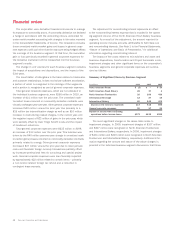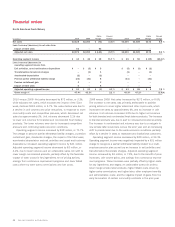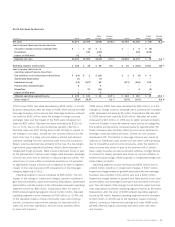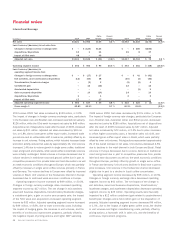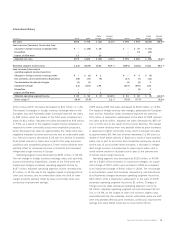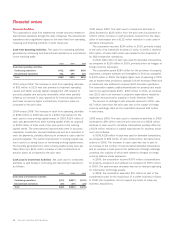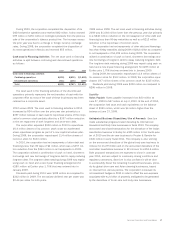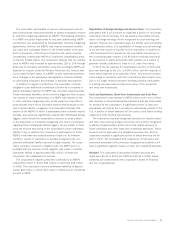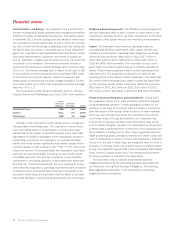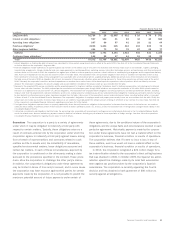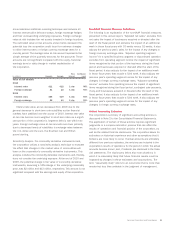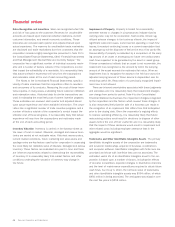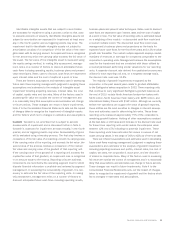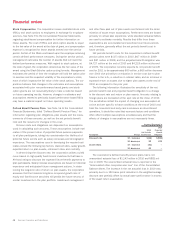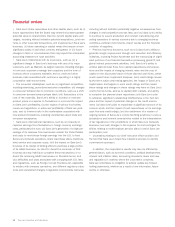Sara Lee 2010 Annual Report Download - page 42
Download and view the complete annual report
Please find page 42 of the 2010 Sara Lee annual report below. You can navigate through the pages in the report by either clicking on the pages listed below, or by using the keyword search tool below to find specific information within the annual report.
Financial review
40 Sara Lee Corporation and Subsidiaries
Credit Facilities and Ratings The corporation has a $1.85 billion
five-year revolving credit facility available which management considers
sufficient to satisfy its operating requirements. This facility expires
in December 2011 and the pricing under this facility is based upon
the corporation’s current credit rating. At July 3, 2010, the corpora-
tion did not have any borrowings outstanding under this facility and
the facility does not mature or terminate upon a credit rating down-
grade. The corporation’s debt agreements and credit facility contain
customary representations, warranties and events of default, as
well as, affirmative, negative and financial covenants with which the
corporation is in compliance. One financial covenant includes a
requirement to maintain an interest coverage ratio of not less than
2.0 to 1.0. The interest coverage ratio is based on the ratio of EBIT
to consolidated net interest expense with consolidated EBIT equal
to net income plus interest expense, income tax expense, and
extraordinary or non-recurring non-cash charges and gains. For the
12 months ended July 3, 2010, the corporation’s interest coverage
ratio was 7.8 to 1.0.
The corporation’s credit ratings by Standard & Poor’s, Moody’s
Investors Service and FitchRatings, as of July 3, 2010, were as follows.
Senior
Unsecured Short-term
Obligations Borrowings Outlook
Standard & Poor’s BBB A-2 Stable
Moody’s Baa1 P-2 Stable
FitchRatings BBB F-2 Stable
Changes in the corporation’s credit ratings result in changes in
the corporation’s borrowing costs. The corporation’s current short-
term credit rating allows it to participate in a commercial paper
market that has a number of potential investors and a historically
high degree of liquidity. A downgrade of the corporation’s short-term
credit rating would place the corporation in a commercial paper
market that would contain significantly less market liquidity than it
currently operates in with a rating of “A-2,” “P-2,” or “F-2.” This would
reduce the amount of commercial paper the corporation could issue
and raise its commercial paper borrowing cost and would require
immediate payment or the posting of collateral on the derivative
instruments in net liability positions in accordance with ISDA rules.
See Note 15, “Financial Instruments” for more information. To the
extent that the corporation’s operating requirements were to exceed
its ability to issue commercial paper following a downgrade of its
short-term credit rating, the corporation has the ability to use avail-
able credit facilities to satisfy operating requirements, if necessary.
Off-Balance Sheet Arrangements The off-balance sheet arrangements
that are reasonably likely to have a current or future effect on the
corporation’s financial condition are lease transactions for facilities,
warehouses, office space, vehicles and machinery and equipment.
Leases The corporation has numerous operating leases for
manufacturing facilities, warehouses, office space, vehicles and
machinery and equipment. Operating lease obligations are sched-
uled to be paid as follows: $80 million in 2011, $57 million in
2012, $42 million in 2013, $28 million in 2014, $21 million in
2015 and $69 million thereafter. The corporation is also contin-
gently liable for certain long-term leases on property operated by
others. These leased properties relate to certain businesses that
have been sold. The corporation continues to be liable for the
remaining terms of the leases on these properties in the event that
the owners of the businesses are unable to satisfy the lease liabil-
ity. The minimum annual rentals under these leases are as follows:
$22 million in 2011, $17 million in 2012, $14 million in 2013,
$12 million in 2014, $12 million in 2015 and $28 million thereafter.
Future Contractual Obligations and Commitments During 2007,
the corporation exited a U.S. meat production plant that included
a hog slaughtering operation. Certain purchase contracts for the
purchase of live hogs at this facility were not exited or transferred
after the closure of the facility. Under the terms of these contracts,
which are open through June 2012, the corporation will continue
to purchase these live hogs and therefore, the corporation has
entered into a hog sales contract under which these hogs will be
sold to another slaughter operator. The corporation’s purchase price
of these hogs is generally based on the price of corn products, and
the corporation’s selling price for these hogs is generally based on
USDA posted hog prices. Divergent movements in these indices will
result in either gains or losses on these hog transactions. Expected
losses from the sale of these hogs are recognized when the loss is
probable of occurring. At the end of 2010, based on current market
pricing, the corporation deemed that it was not probable that material
future near-term losses would occur. The contractual commitment
for these purchases is included in the table below.
The corporation has no material unconditional purchase
obligations as defined by the accounting principles associated with
the Disclosure of Long-Term Purchase Obligations. The following
table aggregates information on the corporation’s contractual
obligations and commitments:


